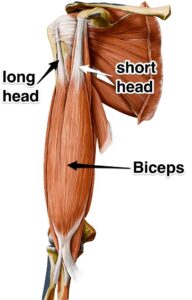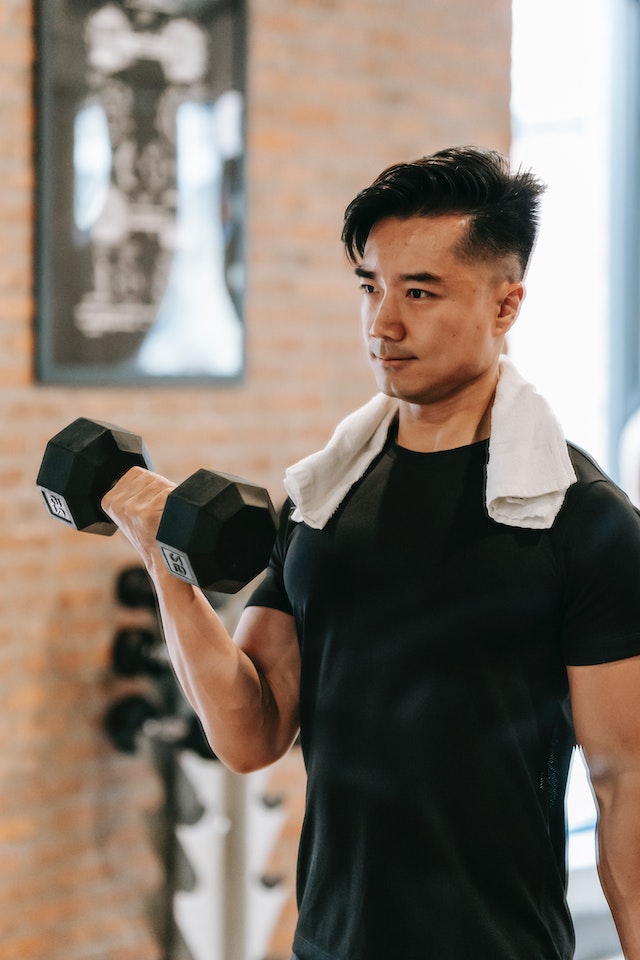For Building a Big and Bulky bicep the longhead bicep can’t be ignored. The Long Head of the Bicep originates from the supraglenoid tubercle of the glenoid/scapula. Its main function is elbow flexion and supination of the forearm. It gives the bicep a well-rounded and proportionate look.
Anatomy of the Bicep Muscle:

The brachii is a two-headed muscle positioned in the upper arm. It consists of the long head and the short head. The long head of the bicep originates from the supraglenoid tubercle of the scapula and runs down the arm to insert on the radial tuberosity. While both heads contribute to arm flexion, the long head plays a crucial role in the overall shape and size of the biceps.
Importance of Training the Longhead Bicep:
Emphasising the long head of the bicep is essential to achieve well rounded and bulky arm. It adds fullness to the upper arm, creating a visually appealing peak when flexed. Ignoring the long head can result in an imbalanced appearance. It can also limit your overall bicep growth potential. Therefore, including specific exercises that target the longhead bicep is crucial for well-shaped arm development.
Effective Exercises to Target the Longhead Bicep:

- Barbell Curls: Start by holding a barbell with an underhand grip, palms facing up. Curl the weight up towards your shoulders, focusing on the contraction in the biceps.
- Preacher Curls: Utilize a preacher bench and position your upper arms firmly on the pad. With an underhand grip, curl the weight up, keeping your elbows stationary throughout the movement.
- Hammer Curls: Hold a pair of dumbbells with a neutral grip (palms facing each other). Curl the weights up, focusing on keeping the tension on the longhead bicep throughout the exercise.
- Incline Dumbbell Curls: Lie back on an incline bench with a dumbbell in each hand. Curl the weights up while maintaining a slight arch in your lower back.
- Cable Curls: Attach a straight bar to a low pulley cable machine. Stand facing the machine and curl the bar up, keeping your elbows close to your sides.
- Concentration Curls: Sit on a bench, rest your elbow on your inner thigh, and curl a dumbbell uptowards your shoulder. This exercise allows for maximum isolation of the bicep muscle.
Tips for Maximizing Longhead Bicep Development:
To get the most out of your longhead bicep training, consider the following tips:
- Focus on Mind-Muscle Connection: Concentrate on feeling the contraction in your longhead bicep during each exercise. Visualize the muscle working and make a conscious effort to engage it fully.
- Use Progressive Overload: Gradually increase the weights you lift over time to challenge your muscles and promote growth. However, always prioritize proper form and technique to avoid injury.
- Vary Rep Ranges: Incorporate both higher and lower rep ranges into your training routine. Higher reps with lighter weights can help improve muscle endurance, while lower reps with heavier weights stimulate muscle strength and size.
- Prioritize Eccentric Contractions: Slow down the lowering phase of each repetition to emphasize eccentric contractions, which can lead to greater muscle damage and subsequent growth.
- Allow for Sufficient Rest and Recovery: Muscles grow and repair during rest periods, so ensure you’re getting enough sleep and allowing adequate time between training sessions.
Common Mistakes to Avoid
When training the longhead bicep, it’s important to avoid these common mistakes:
- Using Excessive Momentum: Avoid swinging or using momentum to lift the weights, as this reduces the effectiveness of the exercise and increases the risk of injury.
- Neglecting Proper Form: Maintain proper posture and technique throughout each exercise. This ensures that the longhead bicep is properly engaged and reduces the strain on other muscles or joints.
- Overtraining: Give your muscles enough time to recover between workouts. Overtraining can lead to diminished results and an increased risk of injury.
The Role of Nutrition in Building Biceps:

Proper nutrition is important for muscle. To increase the growth of your long head of the bicep and overall bicep muscles, consider the following:
- Protein Intake: For boosting muscle growth you should consume high-protein foods like beef, mutton, chicken and fish. You can add whey protein to your diet to make up for any deficiencies left by food. Protein is made up of amino acids that are the building blocks of muscles. If you are not consuming enough protein you will end up losing your hard-earned muscles.
- Balanced Diet: Make sure you are eating a balanced diet that includes healthy fats, carbs and the essential nutrients that are required by the body. Try adding veggies and fruits to your diet. If there are any vitamin deficiencies consult a medical practitioner and use vitamin supplements recommended by him.
- Hydration: About 60% of the body of the adult is made up of water. So, you should always be hydrated. It aids in muscle recovery and also prevents muscle cramping. Water also makes your skin healthy. You should at least drink 2 litres of water daily.
Longhead Bicep Workout Routine:
You should always warm up properly before working out as it increases the blood flow to the muscle and reduces the risk of injury.
Here’s a workout routine that targets the longhead of bicep:
- Chin Ups : 3 sets of 8-10 reps
- Close Grip Preacher Curls: 3 sets of 10-12 reps
- Hammer Curls: 3 sets of 12-15 reps
- Incline Dumbbell Curls: 3 sets of 8-10 reps
- Cable Curls: 3 sets of 10-12 reps
- Concentration Curls: 3 sets of 12-15 reps
Conclusion
Targeting the longhead bicep is important for achieving good-looking and well-balanced biceps. By adding exercises that target the long head, exercising with proper form, and following a proper workout routine, you can stimulate the growth of your long head.
Remember to focus on Mind Muscle Connection and Progressive Overload to gain lean muscles that give you that Sleeper Build Look
Now, take action and start implementing these strategies into your training routine. Say goodbye to imbalanced biceps and hello to a set of impressive arms!
FAQs
- How often should I train my biceps? It’s recommended to train your long head of bicep 2-3 times per week, allowing for adequate rest and recovery between sessions.
- Can I solely rely on isolation exercises for biceps? While isolation exercises are effective, it’s beneficial to add compound movements such as chin-ups and rows, as they target multiple muscles, including the long head of the bicep.
- Do I need to lift heavy weights to build my long head bicep? The short answer is No. You don’t need to lift heavy to build your long head. By just focusing on proper form and progressive overload you can grow the long head of the bicep.
- Should I stretch before and after my longhead bicep workout?You should stretch before a bicep workout as it increases blood flow to muscle and prepares it for any strenuous activity
- How long does it take for the long head of the bicep to grow? There isn’t a specific answer to that question. It depends on many factors including your age, diet, sex and workout routine. By consuming a well-balanced diet and working out at least 2 times per week you can maximize your bicep growth. Check Out : My Fitness Journey: How I lost 20 KG in 8 Months
Hello, fellow fitness enthusiasts! I'm Zayn, a Board Certified Fitness and Nutrition Coach. My journey started from a personal commitment to fitness, and over time, this passion ignited a desire to help others unlock their potential. I transformed this passion into my profession, and today, I'm proud to say that I am armed with a plethora of certifications, all testament to my dedication and commitment.
When I'm not advising clients or working on my next blog post, you'll find me trying out new fitness regimes, diving into the latest nutritional research, or practicing what I preach with my own healthy lifestyle. My mission is to help you become the best version of yourself, showing that fitness and nutrition are as much about the journey as they are about the destination.


